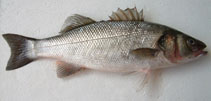| Family: |
Moronidae (Temperate basses) |
| Max. size: |
103 cm TL (male/unsexed); max.weight: 12 kg; max. reported age: 30 years |
| Environment: |
demersal; freshwater; brackish; marine; depth range 10 - 100 m, oceanodromous |
| Distribution: |
Eastern Atlantic: Norway to Morocco, the Canary Islands and Senegal. Also known from the Mediterranean and Black Sea. Absent from White, Barents, Baltic and Caspian Seas (Ref. 59043). |
| Diagnosis: |
Dorsal spines (total): 8-10; Dorsal soft rays (total): 12-13; Anal spines: 3-3; Anal soft rays: 10-12. Diagnosis: head with cycloid scales above; mouth moderately protractile (Ref. 231). Vomerine teeth only anteriorly (Ref. 231), in a crescentic band (Ref. 231, 57391). Scales on interorbital space cycloid (Ref. 57391). Posterior edge of opercle finely serrated, lower edge with strong forward- directed denticles (Ref. 231). 2 flat opercular spines (Ref. 231, 57391). Young with some dark spots on upper part of body (Ref. 231).
Description: elongate fish with 2 separate dorsal fins and a rather deep caudal peduncle; lower preopercular margin with large, forward-pointing spines; vomerine teeth patch not extending to midline of palate; caudal fin moderately forked; scales small, those on interorbital space cycloid (Ref. 57391).
Coloration: back silvery to greyish-blue, sides silvery, belly sometimes tinged with yellow; young individuals may have some black markings, particularly on back but these disappear in adults; a diffuse black spot at upper angle of opercle (Ref. 57391). |
| Biology: |
Adults manifest demersal behavior, inhabit coastal waters down to about 100 m depth but more common in shallow waters (Ref. 54221, 57391). Found in the littoral zone on various kinds of bottoms on estuaries, lagoons and occasionally rivers. They enter coastal waters and river mouths in summer, but migrate offshore in colder weather and occur in deep water during winter in the northern range. Young fish form school, but adults appear to be less gregarious (Ref. 9987). Feed chiefly on shrimps and mollusks, also on fishes (Ref. 5990). Juveniles feed on invertebrates, taking increasingly more fish with age. Adults piscivorous . (Ref. 59043). Spawn in batches (Ref. 51846). Spawning takes place in the spring near the British Isles, and earlier in its southern range. Eggs are pelagic (Ref. 35388). Marketed fresh or smoked (Ref. 9987). Highly sought by sport fishermen (Ref. 30578). |
| IUCN Red List Status: |
Least Concern (LC); Date assessed: 01 January 2008 Ref. (130435)
|
| Threat to humans: |
harmless |
Source and more info: www.fishbase.org. For personal, classroom, and other internal use only. Not for publication.
